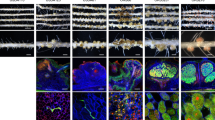Abstract
RHIZOBIUM meliloti is a symbiotic bacterium that elicits the morphogenesis of nitrogen-fixing nodules, specific organs on the roots of alfalfa (Medicago sativa)1. In R. meliloti a series of nodulation (nod) genes have been identified which are involved in root-hair curling and infection and in nodule formation1. The nodABC genes, common to all Rhizobium sp., and the host-range nodH and nodPQ genes are involved in the production of an excreted root-hair deforming factor, NodRm-1, which is a sul-phated and acylated glucosamine oligosaccharide2–7. Here we report that purified NodRm-1 and a related compound, Ac-Nod Rm-1, at concentrations in the micromolar–nanomolar range, elicit cortical cell divisions and the formation of genuine nodules on aseptically grown seedlings of alfalfa. Chemical modifications of NodRm-1, such as the removal of the sulphate group, reduction of the terminal sugar or hydrogenation of the acyl chain result in a strong decrease in the morphogenic activity. A highly specific prokaryotic lipo-oligosaccharide signal is thus able to trigger a genuine organogenesis in a higher plant.
This is a preview of subscription content, access via your institution
Access options
Subscribe to this journal
Receive 51 print issues and online access
$199.00 per year
only $3.90 per issue
Buy this article
- Purchase on Springer Link
- Instant access to full article PDF
Prices may be subject to local taxes which are calculated during checkout
Similar content being viewed by others
References
Long, S. R. Cell 56, 203–214 (1989).
Faucher, C. et al. J. Bact. 170, 5489–5499 (1988).
Faucher, C., Camut, S., Dénarié, J. & Truchet, G. Molec. Pl. Microbe Interact. 2, 291–300 (1989).
Lerouge, P. et al. Nature 344, 781–784 (1990).
Schwedock, J. & Long, S. R. Nature 348, 644–646 (1990).
Roche, P. et al. in Advances in Molecular Genetics of Plant-Microbe Interactions Vol 1 (eds Hennecke, H. & Verma, D. P. S.) 119–126 (Kluwer Academic, Dordrecht, 1991).
Roche, P., Lerouge, P., Ponthus, C. & Promé, J. C. J. biol. Chem. (in the press).
Dudley, M. E., Jacobs, T. W. & Long, S. R. Planta 171, 289–301 (1987).
Truchet, G. et al. Molec. gen. Genet. 219, 65–68 (1989).
Streeter, J. C.R.C. crit. Rev. Pl. Sci. 7, 1–23 (1988).
Spaink, H. et al. in Advances in Molecular Genetics of Plant -Microbe Interactions Vol 1 (eds Hennecke, H & Verma, D. P. S.) 142–149 (Kluwer Academic, Dordrecht, 1991).
Downie, J. A. Molec. Microbiol. 3, 1649–1652 (1989).
Truchet, G., Michel, M. & Dénarié, J. Differentiation 16, 163–173 (1980).
Finan, T. M. et al. Cell 40, 869–877 (1985).
Hirsch, A. M., Bhuvaneswari, T. V., Torrey, J. G. & Bisseling, T. Proc. natn. Acad. Sci. U.S.A. 86, 1244–1248 (1989).
Hollingsworth, R., Squartini, A., Philip-Hollingsworth, S. & Dazzo, F. B. in Signal Molecules in Plants and Plant-Microbe Interactions (ed. Lugtenberg, B. J. J.) 387–393 (Springer, Berlin, 1989).
Kapp, D., Niehaus, K., Quandt, J., Müller, P. & Pühler, A. Pl. Cell 2, 139–151 (1990).
Egelhoff, T. T. & Long, S. R. J. Bact. 164, 591–599 (1985).
Debellé, F. et al. J. Bact. 168, 1075–1086 (1986).
Horvath, B. et al. Cell 46, 335–343 (1986).
Albersheim, P. et al. in Structure and Function of Plant Genomes (eds Ciferri, O. & Dure, L. III) 293–312 (Plenum, New York, 1983).
McDougall, G. J. & Fry, S. C. Pl. Physiol. 89, 883–887 (1989).
Eberhard, S. et al. Pl. Cell 1, 747–755 (1989).
Scheres, B. et al. Cell 60, 281–294 (1990).
Nap, J. P. & Bisseling, T. Science 250, 948–954 (1990).
Truchet, G., Camut, S., de Billy, F., Odorico, R. & Vasse, J. Protoplasma 149, 82–88 (1989).
Maillet, F., Debellé, F. & Dénarié, J. Molec. Microbiol. 4, 1975–1984 (1990).
Boivin, C., Camut, S., Malpica, C. A., Truchet, G. & Rosenberg, C. Pl. Cell 2, 1157–1170 (1990).
Sprent, P. Applied Nonparametric Statistical Methods (Chapman and Hall, London, 1989).
Karlson, K. A., Samuelson, B. E. & Steen, G. O. J. Membrane Biol. 5, 169–184 (1971).
Author information
Authors and Affiliations
Rights and permissions
About this article
Cite this article
Truchet, G., Roche, P., Lerouge, P. et al. Sulphated lipo-oligosaccharide signals of Rhizobium meliloti elicit root nodule organogenesis in alfalfa. Nature 351, 670–673 (1991). https://doi.org/10.1038/351670a0
Received:
Accepted:
Issue Date:
DOI: https://doi.org/10.1038/351670a0
Comments
By submitting a comment you agree to abide by our Terms and Community Guidelines. If you find something abusive or that does not comply with our terms or guidelines please flag it as inappropriate.



